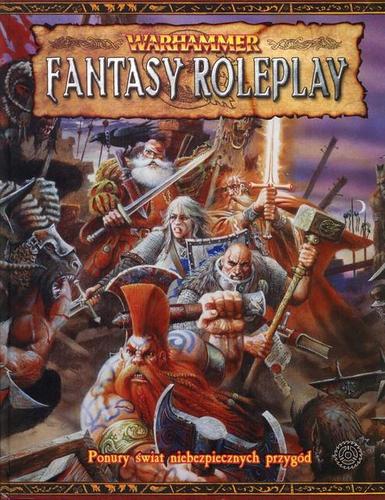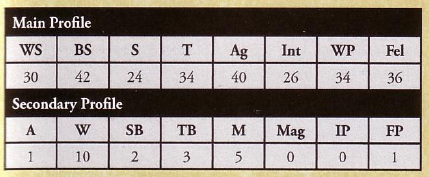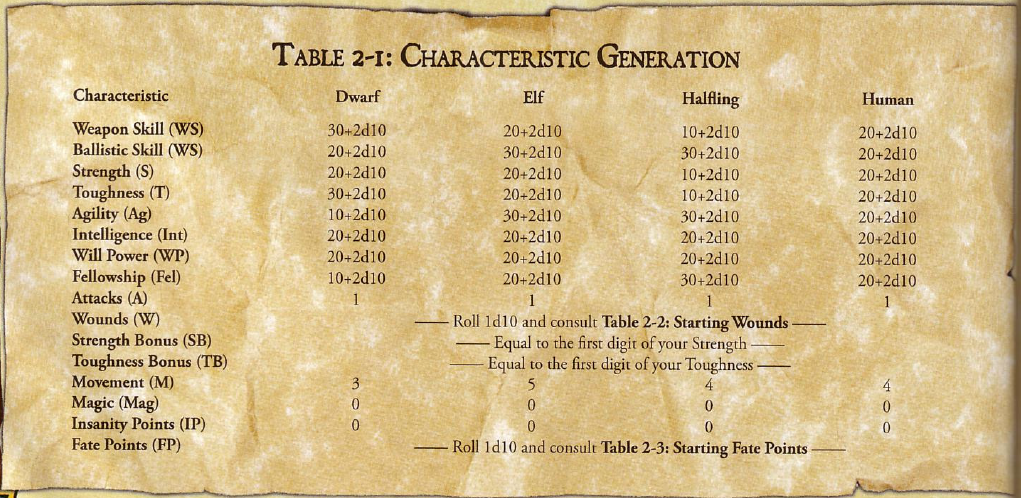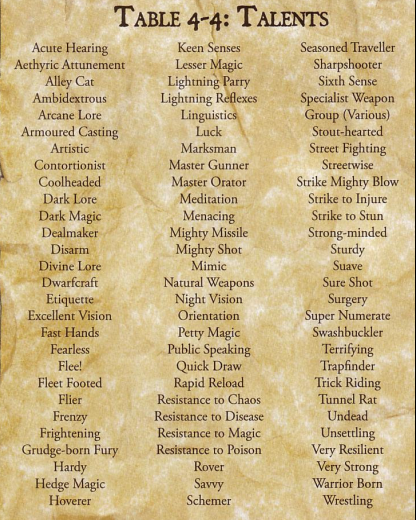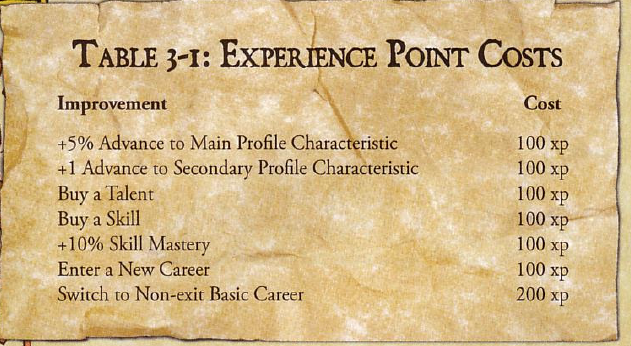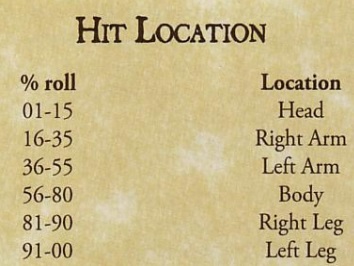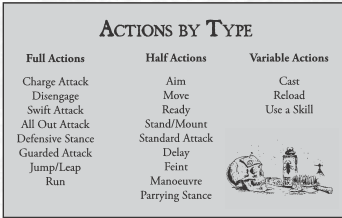Warhammer Fantasy Roleplay 2nd Edition
From Roll20 Wiki
Contents
|
Warhammer Fantasy Roleplay 2nd Edition
- EDITORS NOTE: Welcome current, future, and prospective players! I'll be attempting to flesh out this wiki for the Warhammer Fantasy Roleplaying Game. This will be specifically for the second edition of the game.
Please feel free to contribute as if I do this myself, it will take quite ( a lot) of time.
I'm still deciding how I want to split this wiki up and not just dump a ton of information up front so, changes to formatting may be a bit jarring in these early stages.*
The complete series of books for this edition of WHRPG are openly available with a quick search with your preferred search engine, so I won't really use this space to detail every rule. I wish to give an overview so you can see how the game would be played, some cheat sheets, FAQ, and clarifications that tripped me up when playing. I welcome and even urge you to contribute to the FAQ section (coming soon!) as well. The more of us on this, the better it is for everyone.
Macros
So I'm still new to the way Roll20 works, but as I understand, the use of macro's wouldn't really be needed while using the character sheets provided here. When the game is created by the GM, he or she will be given a choice what character sheet templates to use. Despite the slightly poor ability to get a good plain text export of the sheet for printing, the advanced character sheet created by Axel Mellgren,makes short work of any macro's that I can tell. All rolls can be done from the character's sheet provided by Axel Mellgren take care of the rolling, as long as you fill out the sheet properly. As far as I can tell, the macros needed to roll the specific scores and attributes are accurate and all work. You may wish to create customs of course, but so far I haven't the need. I have yet to use to "Simple" character sheet version, but it appears as though it has the same functionality, but presented on a more simple page that looks to be more printer friendly.
How the Dice Mechanics Work
A thing to note about dice in WHFRPG, is that the system uses a "percentile" based system. Don't worry, put the calculators away and wipe up the sweat. It's easy stuff, and when you're using the rolling system provided by Roll20.net, it makes it even simpler than it would be if you were playing offline. Here's how it works:
Your character will have a list of traits, or stats. These are things like Weapon Skill, Ballistic Skill, Strength, Intelligence etc. Theses stats or "characteristics" as the game officially calls them, are rolled up during your character creation process. Now I'll explain more about this later, but for now, Let's assume you have a character with a Weapon Skill of 30. The way dice work in this systems is that you roll d10's. Sometimes, you will be asked to generate a number between 1 and l0. To do this, simply roll one die and read the result. When you roll this way, try to roll as high as possible (unless stated otherwise)
The other type of dice roll in WHFRPG is called a percentile roll. A percentile roll uses two d1O to create a number between 1 and 100. Now you *may* be tempted to say that you can just roll a 1d100 and be done with it. But no, do not do this. There are many times and situations where you literally need both numbers separated. We'll come to those situations later, but for now... just roll the 2d10, and the chatroom roller will add them together for you anyway.
TL;DR - Roll 1d10 for simple things, and 2d10 for things like attack,and skill checks, xd10's for spell casting (it's up to the pc how many to use)
The Playable Races
The character creation process starts with an important question: What race do you want to play? In Warhmnmer Fantasy Roleplay, you can choose from four: Dwarf, Elf, Halfling, and Human. Each race has different strengths and weaknesses. An overview of each race is below. The bonuses, and abilities of each I'll lay out in the later section.Once you've read these over, pick the race that appeals to you most. Then you’ll be ready to move on to the next step, generating Characteristics.
Dwarfs
Dwarfs are a short but burly and resilient race of warriors and craftsmen. Most live under the mountains in mighty holds, with mines extending deep beneath the earth. They are immediately recognizable and short-tempered and they are legendary for their ability to hold a grudge However, Dwarfs are a courageous people and undeniably loyal to their friends and allies. They are struggling to preserve the remnants of their mountain kingdom from Orcs, Goblins, and other foul creatures. Dwarfs have strong ties to the Humans of the Empire and many are now a part of Imperial society.
Elves
Elves are a lithe and graceful race easily recognized by their pointed ears and hawkish features. They have a glorious yet tragic history and are renowned for their archery, learning, and wizardry. Elves have an innate understanding of the ways and currents of nature, particularly the forest and the sea. They despise those that destroy the purity of nature, be they proud Humans, greedy Dwarfs, or evil Ores. V/hile they can be aloof, they have sacrificed more of themselves for the good of the world than the other races can ever know.
Halflings
Halflings are a small but dexterous race who look like Human children to the untrained eye. The fact that they cannot grow beards only reinforces this impression. Although they tend to be pot-bellied, since they eat twice as often as any other race, they are capable of great stealth. When combined with their well known skill with the sling, Halflings can prove to be surprisingly stubborn opponents. They are, however, largely a peaceful people, content to farm, eat, and smoke pipe weed. They are proud of their families and all Halflings can recite their family lineage back ten generations or more.
Humans
Humans are the most common race in the Old World and the founders of the Empire. W/hile they are neither as tough as Dwarfs not as wise as Elves, Humans are a vibrant and energetic race that has achieved much in a short time. They are tremendously adaptable, which is both a great strength and a serious weakness. ‘Whilst many heroic Humans have fought against the tide of darkness, it is an uncomfortable truth that they also provide the lion’s share of the hordes of Chaos.
Character Stats
Your PC is defined by Characteristics, which represent your character’s raw ability in a variety of physical and mental areas. These are broken into two groups, the Main Profile and the Secondary Profile. The Characteristics in the Main Profile are rated on a scale of O-100, with higher scores being better. The characteristics in the Secondary Profile are usually rated on a scale of 1-1O and again higher scores are better. Here's a sample of what your character's profile may look like:
If you all are familiar with D&D and most any other roleplaying game, these stats should be moderately familiar, but provide a slightly bit more granularity in my opinion, than the D&D stats.
Main Profile Stats
Weapon Skill (WS) - This is your characters innate skill with a melee weapon. Doesn't specify strength, but just overall how handy you are in close combat.
Ballistic Skill (BS) - This is your character's innate skill with a ranged weapon. Like Weapon skill, it's how good, and skilled you are at the art of long ranged weapon handling.
Strength (S) Your characters overall strength and physical ability to move things, and brawniness.
Toughness (T) Represents your characters ability to withstand a blow, take a hit, resist poison, not faint from blood loss etc.
Agility (Ag) Represents your characters ability to move quickly, reflexes, dexterity, and reaction to events.
Intelligence (Int) Represents your character's intellect, ability to reason, power of deduction and knowledge of the world around him/her.
Will Power(WP) Your mental toughness, resolve, determination, and ability to withstand mental stress.
Fellowship (Fel) Represents your charm, leadership, personal charisma, and social acumen.
Secondary Profile Stats
Attacks (A) This is your character's ability to strike and how often those strikes land. This is the maximum number of attacks you can make in a round.
Wounds (W) This is your character's general vitality, and "HP". How much damage you can take before falling.
Strength Bonus (SB) This is your character's ability to inflict damage and wounds to a target. Derived from your character's Strength.
Toughness Bonus (TB) Derived from your character's toughness. Used to resist damage from outside attack.
Movement (M) Your speed to move across land. Mainly used for combat scenarios.
Magic (Mag) Represents your character's magical power. This is rare trait to acquire and is generally dependent on your career and training.
Insanity Points (IP) Represents your character's state of mind. The more points you acquire here, the more your character loses his sanity and can be influenced by...darker forces.
Fate Points (FP) Fate is your luck, and "destiny". Can be used to avoid some pretty awful things like...death.
Generating Character Stats
So, your starting Characteristics are heavily influenced by your characters race. To generate the Characteristics of your character’s Main Profile,you’ll need two 10-sided dice. Or..if you're using Roll20's chatroom, you need that button that you click that says 2d10 :P The Main Profile stats are 2d10, + whatever racial bonus you get. The different rolls that you need per stat are given on the table 2-1, that I've included below. Match the Stat with the race that you chose and look at the modifier. For example To roll your Strength, if you were an Elf, you would roll 2d10 and add 20.
Most of the secondary profile stats are derived from your prior rolls, and table numbers and racial traits. Here's how you determine each:
Attacks The base number of attacks that you get is always 1. This can be modified with the choice of a career that adds to this value.
Wounds (W) You would roll 1d10 for this and then consult the table 2-2, "Starting Wounds". I've included it below for reference. Wounds are basically the "Hit Points" that your character has.
Strength Bonus (SB) This number is the first digit of your Strength Stat from your Main Profile. (Hopefully it's atleast higher than 19 then!)
Toughness Bonus (TB) This number is the first digit of your Toughness stat from the Main Profile.
Movement(M) These are given to from your race. As before the table is below.
Magic (Mag) Everyone starts with 0 but your career will determine your bonus. (surprisingly Elves don't have an innate magical ability)
Insanity Points (IP) Starts at 0 (thankfully!! Though starting out with an insane character would be fun...hmm)
Fate Points (FP) To generate this, roll 1d10 and consult the table 2-3 which I have put below.
Don't forget! If you don't like the way one of your stats came out, you can invoke the rule of Shallya's Mercy and go for the base stat of your race + 11 instead!
Skills
So aside from your main and secondary profile stats that you generated, your race also comes with some abilities that you get. It gives each race a unique flavor from each other. As the list is a bit long, I will not be posting each of the races starting Skills and Talents here, but note that the are on page 19. Also as a GM atleast for myself, I would recommend the idea of letting players have a bit of freedom with these starting abilities. Look at it this way, a Dwarf raised in one part of the world is going to have different language, and skills than a Dwarf who grew in a different area. Everything comes into play in the skills we develop and learn, even things like climate, terrain, political views, etc.. So I figure if the player character can justify it with a backstory, then allow them to maybe swap a skill or talent out for one more suited to the origin of their character.
What are these alleged racial traits? Well, your character gets two types. Skills and Talents. Skills are things learned. Either by being born into a certain race, or learned by developing the skill due to a career, or just a skill that you cultivated due to your environment. Skills are split into Common Skills and Advanced Skills. Common or basic skills are things that any 'ol fool can attempt (at a -30% penalty) even if he doesn't have that particular skill. They represent things that you can try valiantly even if you're untrained in the art. Then there are Advanced Skills, where they actually require your knowledge and training to perform. For these, you must actually have bought or have a class or race that has that skill. Advanced skills literally can not be attempted without them.
Some of these I have problems with, and as a GM you should feel empowered to switch some around if you feel an advanced skill should be considered common. Below is a list of the basic and advanced skills from the Core Book.
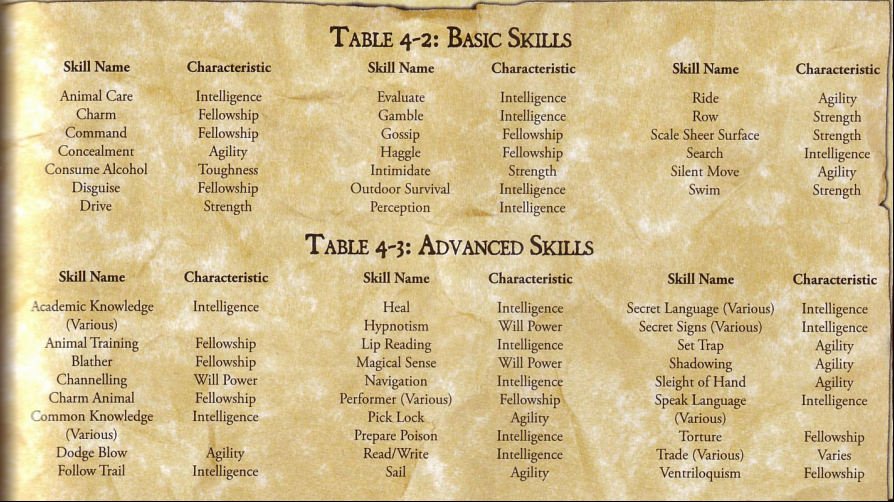
Talents
The other set of bonus you receive is something called a Talent. Talents are different from skills in that they really aren't something that you test for, it's more of some ability that you naturally possess. For example, if you choose an Elf as a starting race, you automatically get the "Excellent Vision" talent, as well as "Night Vision". If you picked a human, you get to choose your talents! Goes to show how versatile humans can be. Talents can give you some really interesting abilities and a very good way to carve out the uniqueness of your character. The same rules apply as for talents. You get a few depending on your race/career, and then from there you can buy them for 100 XP each. Talents though don't stack, so there is no "talent mastery". Though as a GM, you can change this. Some talents, lend themselves to the idea of being able to 'master' and perhaps gain an additional bonus, or extra attack. Here's a list of Talents from the Core Book:
Leveling Up aka "Advancing" Your Character
So if you're familiar with the sort of "gold standard" of RPG's Dungeons and Dragons, then the mechanics of increasing level and stat points have set the way for many many carbon copies. This is something is changed up in WHFRPG. There actually are not real levels in the game per see. The experience systems works in a very free form way, and it actually took a few read throughs to 'get it'. It basically amounts to this... The GM is given discretion to hand out XP as he see's fit. But as a scale characters can 'spend it' 100XP at a time to increase certain stats, or buy skills, or enter new career paths etc... See the table below for the list of how to use garnered (and hopefully well earned!) experience points:
As shown above, the PC's can choose how to spend their gained experience points. Generally GM's should let their PC's spend it hamper free, but things like career changing may require additional requirements such as actually having access to the training required, or tutelage of studying under someone to learn the art. To not get in the way too much of gameplay I wouldn't put *too* much into this though, as it may deter players from actually trying to advance.
A brief look at each option... For 100 XP you can take a +5% to a main characteristic stat. Now you can't just choose any stat you want. It has to have one that has option to increase. It will depend on your career which ones are available to increase. An example below is from the Baliff Career:
So for example, the Baliff here, after obtaining some XP can choose to spend 100 of it to add +5% to his WS, BS, S, Int, WP, or Fel. That five% advance though may only be applied to one of those, he can not choose to put the 5% increase in T or Ag. Likewise, notice that the WS,BS,S,WP have a +5% while Int and Fel have a +10%. This means that those can advanced twice, at 5% at a time (and for another 100 XP of course!) Like the other stats, you can only do this in 5% increments. So if you wanted to max out your Fel, you would first spend 100XP for the first 5% on Fel, then later on, another 100XP for the final +5% in Fel.
As the 3-1 Advancing chart above shows, you could also spend 100 XP on adding a +1 to your secondary stats. The same rule applies, you can only buy the +1 advance to stats that have a +x number. So you can't add a +1 to Mag if your a baliff.
In addition to these, you can also use your XP to switch or "upgrade" to a new career. Of course you must first meet the entry requirements of that career as well.
Equipment
There are a ton of weapons in the Old World, and due to the nature of the grim and perilous world, anything can be used as a type of way to defend yourself. Weapons are broken up into types, or 'how' they are used, such as snaring, defensive, slow, piercing, impact, unreliable...etc. Each one of these qualities has an affect on the attack,damage, speed, safety of using it. Armor has a similar role and gives you the ability to use "basic" armor rules, and "Advanced Armor" rules. The basic armor rules are simple and good if you're starting out, especially since you'll probably be light on armor anyway. Basically if you're using the Basic Armor rules, the following applies:
No Armor: +0 Armor Points Light Armor: +1 Armor Point Medium Armor: +3 Armor Points Heavy Armor: +5 Armor Points
This goes a long way to simplifying the the more advanced armor system. That being said, the advanced armor system is really fun to use, and if you find yourself in a game where combat isn't constant, and you have some time to give, I'd really suggest running with the Advanced rules. Further down is combat rules, which will expand upon this, but basically for attacking and assigning damage, characters have six locations that can be hit. Head, right arm, left arm, body, left and right legs. So instead of having a generic +3 with Medium Armor, if you use the advanced rules, you're head may have a +1, cause you have a light cap, but maybe your torso has a +3 because you are wearing poor quality chainmail.
Combat, Damage, and Armor
Ohh boy, here we go. This will be as concise as I can make it. Again the pdf books for 2nd edition are available so for a full understanding you'll want to refer to them. Let's break this down into steps.
Making an Attack To start an attack on an opponent, you must use an attack action:
- All Out Attack
- Charge Attack
- Guarded Attack
- Standard Attack
- Swift Attack
To attack an opponent in close combat, you need to be within 5 feet, and for ranged attacks, you need to be within the weapon's range and line of sight. With these requisites, you can proceed with the attack.
1. Roll to Hit Roll 2d10 for percentile dice. Refer to your Weapon Skill characteristic for melee attacks and your Ballistic Skill for ranged attacks. Remember you need to roll equal to less than the characteristic.
2. Determine Location of Blow Now that you scored a hit (or not) determine where your blow struck. Take the attack roll, and reverse the order of the dice roll. So if you rolled a 37, then your hit location would be 73. then check the chart here:
2 1/2 Dodge or Parry Attempts This step is an inbetween stage that represents an optional attempt to beat back an attack of melee. This can not be used when taking an attack from a ranged weapon. You can attempt to parry the attack if you entered the parry half action stance at the beginning of your turn, OR if you are brandishing two hand weapons. If you make a successful WS test, you have succesfully fought off the attack, and no damage is dealt. Likewise if you have the Dodge advanced skill, you can make a Dodge skill test at this time and if you succeed, the attack did not hit you and you are in the clear!
3. Roll Damage Now that you have the location of where your blow strikes, roll 1d10 and add the damage for the specific weapon you're using. As seen in the Core Rule book and Equipment and Arms of the Old World, most melee weapons have damage of your Strength Bonus with a modifer, +1d10. For example look below at the chart for melee weapon damage. In the damage column for a Great Weapon, the damage is equal to your Strength Bonus, and you would add the 1d10 roll to this. Likewise the damage for a dagger is your Strength Bonus with a -3 modifier. Then you add the 1d10 roll to that. In general Melee weapons use your Strength Bonus while Ranged weapons have a fixed value for damage, of course exceptions apply, such as with javelins, throwing axes, and whips etc.

4. Opponent Reduces Given Damage Now that you have the total damage that you can potentially deal, that total is reduced by the Armor Points and Toughness Bonus that the Opponent has. So to use the example from the Core book: Given a Ballistic Skill of 42%, if you shoot a goblin and get a 25%, the attack succeeds. You reverse the order of the dice, and the 25 becomes a 52%. Looking at the hit location table, this means it hits the goblin on it's left arm. Now roll damage. The bow you're using has a base damage of 3. Roll 1d10, and let's say you get an 8. 8+3= 11. The goblin being targeted has a toughness bonus (TB) of 2, but has no armor that protects it's arms. So 11-2 = 9 Wounds it takes. Good shot!
5. Record Damage If you suffer any damage despite your toughness and armor, it is reduced from your Wounds total. Same goes for whoever you're attacking. The balance of the damage dealt, from the person's Toughness Bonus and Armor for that body part, will reduce his/her Wounds total. If you or your opponents reach 0 or below wounds, all subsequent attacks are considered critical hits. More about Wounds/Critical Hits/Healing/Damage in the next section.
Combat Rounds
When not embroiled in heated combat, in general time and actions don't really need to tracked. Usually using actions, skills and moving isn't really needed to be tracked in normal roleplaying timing. But when combat started, things need to slow down, and be tracked and managed. As each player and opponent gets a turn, you can perform certain actions in these turns. Very similar to Dungeons and Dragons. Some actions require a full round of focusing just on that action, but some actions can be done quickly with much less time. Actions that require the 1 full round, mean that you can only perform that one single action and nothing else. These are called Full Round Actions. Actions that can be done in half of this time, are called (get this...) Half Round Actions. This means that you can perform two Half round actions in one of your turns. I won't go into each action, but the ones that will be used most often are most common. These include: All Out Attack, Aim/Standard Attack, Parry/Standard Attack, Ready/Cast, Channeling/Cast (Channeling is a special action for magic users)
Spell Casting
Magic is really fun in WHFRPG. I mean seriously, it's probably my favorite employment of magic in any RPG.
8/24/17





